ISSN ONLINE(2320-9801) PRINT (2320-9798)
ISSN ONLINE(2320-9801) PRINT (2320-9798)
Dr. S.Saravana Kumar1, R.Senthil Kumar 2, P.Venkatraman3, M.Thamodharan3, S.Vishnu Prashod3
|
| Related article at Pubmed, Scholar Google |
Visit for more related articles at International Journal of Innovative Research in Computer and Communication Engineering
The major threat in authentication involved in the banking sector is key logging. Key logging refers to monitoring the action of user without their knowledge and illegally accessing it for their own purpose. It can be done either through hardware, software and acoustic analysis. key logging, an approach to counter key logging by the use of authentication protocols which have not provided desired security. Thus, we propose two visual authentication protocols: one is a one-time-password protocol, and the other is a password-based authentication protocol. Our approach for real-world deployment: we were able to achieve a high level of usability while satisfying stringent security requirements.
KEYWORDS |
| Smart phone, QR-code, IMI Security. |
I. INTRODUCTION |
| In addition to advancement in technology and applications, providing security to Net Banking is challenging. In the context of e-banking there are large amount of work and more complexities in providing authentication using graphical password and attacks on them [4]. It is challenging for users to combat key loggers; the only possible method is to use an appropriate security solution [5].The Demerits of Existing System: |
| [1] Session hijacking, an act of tracing the password which is stored in the server through URL for illegal access. |
| [2]. Keyboard and mouse events can be traced by OS calls and OSK keystrokes can be monitored by screenshots spywares. |
| [3]Graphical password with distorted image is difficult to remember. |
| Thus we go for randomized On-screen keyboard, where key-loggers find it difficult to determine the positions of the numbers which keeps changing every time when smart phones scan the QR-code. A QR code contains black modules (square dots) arranged in a square grid residing on a white background, which can be read by a device (such as a camera) and processed until the image can be appropriately interpreted. QR-code is encrypted and decrypted by RSA algorithm. Server will generate public key on backend and an equivalent private key which is to be entered by user. We also provide additional features such as instant transaction and IMI security. |
II. EXISTING SYSTEM |
| Secure authentication protocols is quite challenging, considering that various kinds of root kits reside in PCs (Personal Computers) to observe user’s behavior and to make PCs untrusted devices. Involving human in authentication protocols, while promising, is not easy because of their limited capability of computation and memorization. The attacker is capable of creating a fake server to launch phishing or pharming attacks. Therefore, relying on users to enhance security necessarily degrades the usability. On the other hand, relaxing assumptions and rigorous security design to improve the user experience can lead to security breaches that can harm the users’ trust. |
| There are many Keylogger types, but in general they can be classified in three categories: hardware, software, and web keyloggers. Hardware keyloggers are plugged in the hardware system, between the input devices and a computer [2]. Web keyloggers are web scripts written in Java and can often open an invisible pop-up window and collect user information. Also, it is possible to embed malicious code into vulnerable web sites to collect data entered by the user. |
| Today’s Keyloggers can record keyboard keys pressed by the keys on the virtual keyboard. Such Keyloggers receive consecutive screenshot from the victim’s monitor, and can then identify strokes of the keys.Also today’s Keyloggers instead of running through the Startup, they run through Task scheduler (i.e. they run at a specific time and date, e.g. 5 minutes after loading the operating system), or as a Service in objects in which Antivirus software have less control over their actions. |
| Today’s Keylogger’s makers are capable to change its assembly by using specialized software after creating their Keylogger, so that it encapsulated. After encapsulating the Keylogger, a lot of security software will not have the ability to identify the new Keylogger. |
| Another way in which attackers apply Keyloggers to infect their victims is JDB Keylogger. In fact, this type of Keyloggers is combination of Software Keylogger and Web Keylogger. In this approach, attacker created Java file on a website and written running code of the file in Java on the site. Anyone visit the site; Keylogger will taint his operation system. |
III. PROPOSED WORK |
| The proposing two visual authentication protocols: one for password-based authentication, and the other for one-timepassword. |
| We show that these protocols are secure under several real-world attacks including key loggers. Both protocols offer advantages due to visualization both in terms of security and usability. |
(OTP) One-Time-Password |
| �� The OTP protocol generates random numbers for authentication, where the position of the numbers tends to change for every transaction done by the user. |
| �� The QR code will be on the left-hand side and randomized plain keyboard is in right- hand side thus account holder using his android phone to scan the QR code |
| �� The QR code is decrypted using his private key, then the OTP appear on his mobile , the OTP contain randomized (0 to 9) number placed in different place. |
Password-based authentication |
| �� uses a password shared between the Server and the user, and a randomized keyboard. |
| �� User views a randomized (0 to 9) number placed in different place in (4x4) matrix in his android mobile. |
| �� Then the user click the password in randomized plain keyboard using the mouse with the help of OTP if the password is matched then fund/amount is transferred. |
QR-CODE |
| To use QR codes conveniently you must have a smart phone equipped with a camera and a QR code reader/scanner application feature. Luckily, the newer smart phones models available today often have an app pre-installed on them. Now that you have the tools you need, let’s get to scanning. Go out and find yourself a code. Get out your phone and open the app downloaded or that already exists. Steady your hand while the QR code is centered on the screen, as soon as it is done scanning whatever information were stored in the QR code should be displayed to the user. |
RSA Algorithm |
| Step: 1. Choose two very large random prime integers: p and q |
| Step: 2.Compute n and φ(n): |
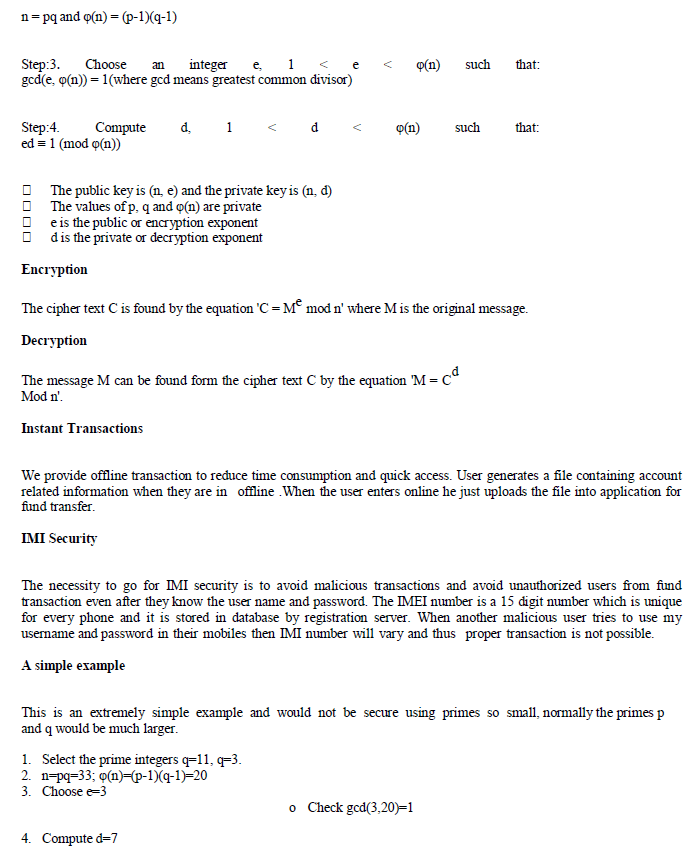 |
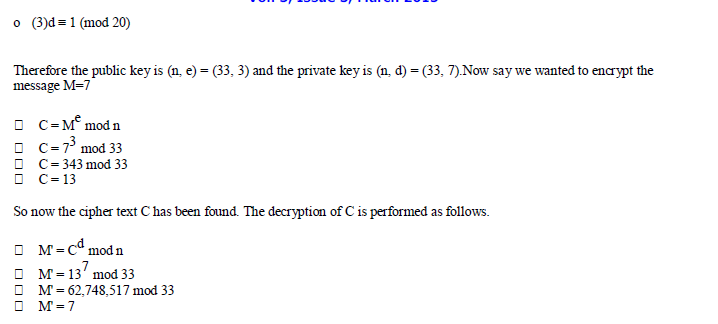 |
| As you can see after the message has been encrypted and decrypted the final message M' is the same as the original message M. A more practical way to use the algorithm is to convert the message to hexadecimal and perform the encryption and decryption steps on each octet individually. |
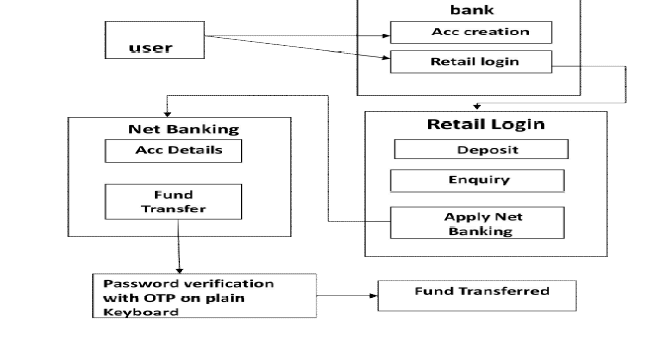 |
MODULES |
| �� Create New Account |
| �� Apply Net Banking |
| �� Randomized Onscreen Keyboard |
Create New Account |
| User create a new account in our banking application to give an input for user detail in our new account registration .User detail must be a valid information (ex:-phone-no, Username, etc...) and the form is submitted to corporate. |
Apply Net Banking |
| User receives an account number h e /she is entering a retail login and applies a net banking as services. This service allows the account holder to view his profile, account details and to transfer the fund in another account. |
Randomized Onscreen Keyboard |
| Account holder transfer the fund in another account he/she enter the account number and amount then before enter the password. Our banking application uses a two visual authentication protocols. |
IV. SCREENSHOT |
HOME PAGE |
 |
REGISTRATION FORM |
 |
ACCOUNT VERIFICATION |
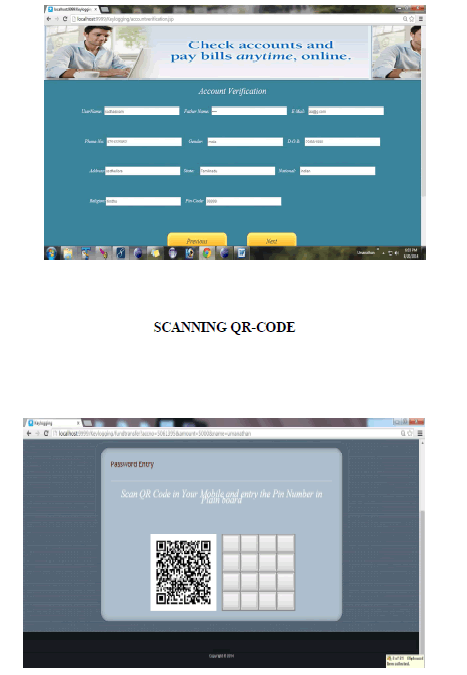 |
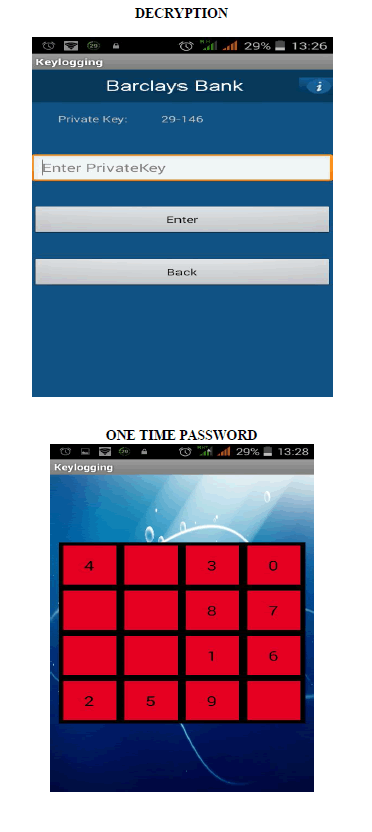 |
FUND TRANSFER |
 |
V. CONCLUSION |
| Thus using visual authentication protocols we provide more security to the banking transaction than ordinary authentication protocols. The additional features to our system is Instant transaction and IMI security. |
VI. FUTUREWORK |
| In future we try to provide alpha-numeric characters as password which will make key loggers difficult to crack the password. |
References |
|